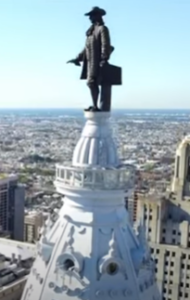Title: City Hall construction foreman
Birthdate: February, 1856
Death Date: August 5, 1902
Plot Location: Section 130, Lot E18

Daniel Barry’s father, Marine Corps Sgt. David Barry, was a Civil War veteran, who, with wife Lucy, had four girls and three boys. The oldest one was called Dan.
Sometimes children grow up wanting to be just like their father and sometimes they want to be the opposite. It’s quite possible Dan admired his father’s tough exterior, but longed to express his freedom from military order and discipline. Dan the daredevil was a doer, but a slight slip was all it took to do him in.
David settled in Maine after his emigration from Ireland and it was there he married Lucy Rogers from Long Island. That’s where Dan was born, but shortly afterward they found their permanent residence in Philadelphia where their other six children were born and spent their entire lives.
Dan made his own way in life starting at 19 when he married 14-year-old Louisa Sheer. How could such a marriage be legal? They took the ferry to Camden, where “marrying parsons” like Rev. William H. Burrell united thousands of couples in legal matrimony because a license wasn’t required in New Jersey.
Two years later their only child, a daughter named Rydie, was born. Dan worked as a ship joiner, one who makes wooden structures inside a ship, like panels, lockers, bunks, and furniture. In the mid-1880s he started work as a painter during  the construction of Philadelphia’s new City Hall, and soon became a foreman, or “boss rigger” as the tower rose in the 1890s.
the construction of Philadelphia’s new City Hall, and soon became a foreman, or “boss rigger” as the tower rose in the 1890s.
The building itself was started in 1872 but the tower wasn’t finished until 1901. Rising from behind the north entrance in the inner courtyard, the four-sided masonry tower features a clock on each side, topped by an eight-sided iron dome beneath a glass-enclosed observation deck.
A 37-foot statue of Pennsylvania’s founder, William Penn, is the cherry on top. Known affectionately by locals as “Billy Penn,” his likeness weighs in at 27 tons and the top of his Quaker hat is 548 feet above the street below.
America’s largest municipal building has 700 rooms and houses all three branches of government: legislative chambers, mayor’s office, and part of the city’s judicial system. It was made of 88 million bricks, plus marble and limestone up to the clock level. The technology to use steel wasn’t developed until around 1890, so the dome of the tower is the  only part with an iron structure.
only part with an iron structure.
The photo above shows Dan on the edge of the clock dial level. He knew that ledge well, because that’s where a large platform was constructed to hold the scaffolding around the dome in 1894. His obituary says he was in charge of all the rigging as the statue was hoisted in 14 pieces to the top in late 1894.
He was most likely one of the workers described in this article about the installation of the final piece, the head and hat:
“The head went airborne and was in place 22 minutes after liftoff, with one worker fastening bolts inside to secure the final piece along with thirteen men on the temporary cage surrounding the statue as they were controlling the ropes with the derrick crane lifting. Workers soon opened the top hatch and cheered and waved their hats from the top, with an American flag temporarily placed on the top.”
This photo from January, 1895 shows the scaffolding removed from the statue but still in place above the observation deck, and the iron dome ready to be enclosed. In October of 1898 the city hosted a Peace Jubilee to celebrate the end of the Spanish American War, with a visit from President William McKinley. Dan and his boss, John Bunker, opened the hatch at the top of Billy Penn’s hat to unfurl an American flag.
He earned the nickname, “Steeple Jack” because he would place electric lights around the brim of the hat, and would occasionally lower himself over the edge and hang in midair by his hands. One source said, “his many adventures and perilous feats would fill a good-sized volume.”
The last item on the “punch list” after construction was painting the inside of the metal dome. Dan’s crew was still doing that in August of 1902. He had told his wife they had saved enough to buy a home and he wouldn’t have to work much longer. But as the crew painted, the scaffolding on which he stood slipped slightly, causing him to lose his balance and fall 90 feet to the floor of the clock level.
have to work much longer. But as the crew painted, the scaffolding on which he stood slipped slightly, causing him to lose his balance and fall 90 feet to the floor of the clock level.
The home Dan and Louisa rented on Moore Street was next door to Louisa’s sister and  brother, who must have been a great comfort during this difficult time. Just three years later, Louisa became ill and succumbed to uremia, or end stage renal disease, at age 44. The couple’s grave is in Section 130, known as the Wharton Street Methodist Episcopal Church section.
brother, who must have been a great comfort during this difficult time. Just three years later, Louisa became ill and succumbed to uremia, or end stage renal disease, at age 44. The couple’s grave is in Section 130, known as the Wharton Street Methodist Episcopal Church section.

Support the Friends of Mount Moriah
Help us in our mission to restore and maintain the beautiful Mount Moriah Cemetery by donating to our cause or volunteering at one of our clean-up events.

